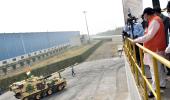Four Chinese soldiers were killed during a fierce hand-to-hand battle with the Indian Army in the Galwan Valley in eastern Ladakh in June last year, the People's Liberation Army acknowledged for the first time on Friday, eight months after the biggest military confrontation between the two neighbours in over five decades.

China's military authorities have honoured two officers and three soldiers, including four who received the awards posthumously, for defending the country's western border, the official Xinhua news agency reported, quoting the The People's Liberation Army Daily, the newspaper of the Chinese military.
Five Chinese frontier officers and soldiers stationed in the Karakoram Mountains have been recognised by the Central Military Commission of China (CMC) for their sacrifice in the border confrontation with India, which occurred in the Galwan Valley in June 2020, the PLA Daily said.
The CMC is headed by Chinese President Xi Jinping, also General Secretary of the ruling Communist Party of China.
The title of 'border-defending hero' was conferred on Battalion Commander Chen Hongjun posthumously, while Chen Xiangrong, Xiao Siyuan and Wang Zhuoran received first-class merit.
Qi Fabao, who was seriously injured in the skirmish, received the title of 'hero regiment commander for defending the border', the Xinhua report said.
Three PLA soldiers were killed in the combat while another soldier died while crossing the icy river when he went to support his army mates.
Asked why China chose to reveal the casualties suffered during the Galwan incident after over eight months, Chinese Foreign Ministry spokesperson Hua Chunying said, 'the report has been revealed to give the truth to the public because the truth is long awaited and is necessary for the people to know the true story'.
India has said that 20 of its soldiers were killed in the fierce hand-to-hand combat on June 15 in Galwan Valley, an incident that marked the most serious military conflicts between the two sides in over four decades.
While China acknowledged casualties, it did not disclose details.
"These heroes will along will be remembered by the Chinese people. Their sacrifices made to defend our territory will never be forgotten by the Chinese people," she said.
"We all know that conflict broke out in Galwan in June last year and responsibility does not rest with Chinese side," Hua claimed.
Bearing in mind the overall interests of relations between the two countries and the two militaries, China has 'exercised a high degree of restraint to cool down and ease the situation, which shows its magnanimity and high sense of responsibility as a major country', she said.
"We hope that the border issue will be put in a proper place in bilateral relations, and the Indian side will make joint efforts with us to properly settle the relevant issue and safeguard overall bilateral relations.
"India is an important neighbour, and the restoration of a sound, stable China-India relationship serves the common aspiration and interests of both peoples.
"We hope the Indian side can work with China in the same direction," she said.
Senior Colonel Ren Guoqiang, Spokesman for the Chinese Ministry of National Defence said that China's position on resolving the China-India border issue is clear, consistent and sincere.
'China is always committed to resolving disputes through dialogue and negotiation, maintaining the general situation of the relations between the two sides, promoting the cooling and easing of the situation, and restoring the peace and tranquility in the China-Indian border areas as soon as possible,' Ren said in a statement.
The state-run Global Times also released a propaganda 'on-site video' of the Galwan Valley border clash.
Asked whether the details of the Galwan incident revealed by China will impact Saturday's 10th round of Commanders-level talks to discuss further disengagement of troops, the Chinese foreign ministry spokesperson said these are two separate issues.
"Through diplomatic and military channels of the two sides are in communications in completing the disengagement smoothly," she added.
"We hope the Indian side will bear in mind the general interest of bilateral relations and bring the ties to the right track. What we released is just the facts and the truth," she said.
The border standoff between the Indian and Chinese militaries erupted on May 5 last year following a violent clash in the Pangong Lake areas and both sides gradually enhanced their deployment by rushing in tens of thousands of soldiers as well as heavy weaponry.
The Chinese soldiers used stones, nail-studded sticks, iron rods and clubs in carrying out brutal attacks on Indian soldiers after they protested the erection of a surveillance post by China on the Indian side of the Line of Actual Control (LAC) in Galwan.
The PLA Daily claimed that the Indian soldiers attacked the Chinese military personnel with steel tubes and cudgels and threw stones.
This is the first time China has acknowledged casualties and details of these officers and soldiers' sacrifice, four of whom died when dealing with the Indian military's 'illegal trespassing' of the Galwan Valley.
The Russian official news agency TASS reported on February 10 that 45 Chinese servicemen were killed in the Galwan Valley clash. According to an American intelligence report last year, the number of casualties on the Chinese side was 35.
The Galwan incident was the biggest confrontation between the two militaries after their 1967 clashes in Nathu La when India lost around 80 soldiers while over 300 Chinese army personnel were killed.
The India-China border dispute covers the 3,488-km-long LAC.
China claims Arunachal Pradesh as part of southern Tibet, while India contests it.
The Global Times said the PLA Daily while acknowledging the Galwan Valley casualties stated that the four soldiers were killed fighting the "foreign military" without referring to the Indian Army.
The admission of the casualties by the PLA coincides with the ongoing disengagement of troops by both sides at the North and South banks of the Pangong Lake, the most contentious part of the standoff which began last year.










